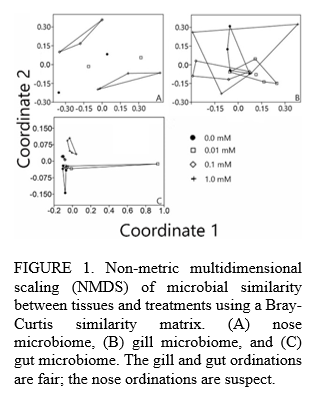THE IMPACTS OF SUBLETHAL NITRITE EXPOSURE ON GOLDFISH MICROBIOMES
Disease in aquaculture production threatens farms and undermines food supplies . Therefore , it is vital to understand immune health and disease transmission within farmed stock and into wild populations. Immune health is intertwined with numerous systems including the microbiome. Disruption of the microbiome, dysbiosis, can contribute to disease. A possible disruptor are agricultural pollutants which include excess nutrients, like nitrites. However, it is unclear how nitrites impact the microbiomes of various tissues and how these changes impact immune health. Additionally, a main portal for pathogen entry in fish is their nose; nasal infections can result in damage to the olfactory and nervous systems. This work aims to determine the impacts of sublethal levels of nitrite on the nasal microbiome and compare it to the gill and gut microbiomes.
Goldfish were held for 2 months under nitrite concentrations: 0.0 mM (control), 0.01 mM, 0.1 mM, and 1.0 mM. Tissue samples were collected from the nose, gills, and gut. The bacterial composition of the m icrobiome was characterized with high-throughput 16S rRNA gene sequencing. The gill microbiome showed no difference in community composition (Fig. 1) . There was not enough evidence in the nose microbiome to determine a different composition, however, there appears to be a shift toward more diversity (Fig. 1). T he gut microbiome showed a significant shift in composition as the level of nitrite increases. Sublethal levels of nitrite exposure significantly increases the diversity of microbial communities in gut microbiomes (Fig. 1). Therefore, environmental nitrites affect the composition of the microbiome in various tissues which could have detrimental consequences in normal physiological function in fish. Future experiments will increase sample size to better elucidate impacts to nose and gill microbiomes. We are working on developing probiotics to combat dysbiosis and prevent the negative impacts of nitrite exposure.
